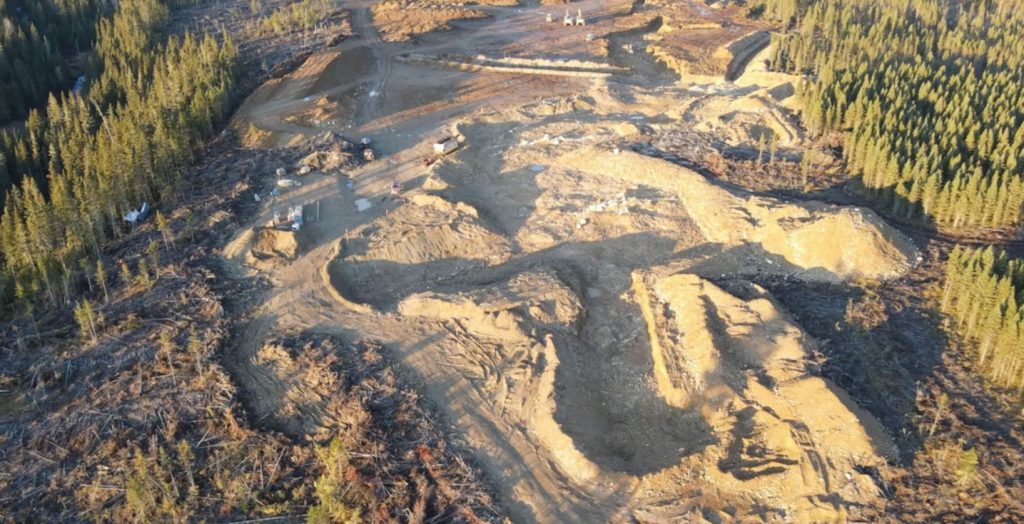Puma Exploration flies magnetic drone survey at Williams Brook, New Brunswick

Puma Exploration Inc. [TSXV-PUMA; OTCQB-PUMXF] has launched a high-resolution magnetic survey at its 100%-owned Williams Brook property in northern New Brunswick. The drone survey will be flown over 6 km of the Lynx Gold Trend and a width of 2 km, where recent drilling confirmed the presence of a favourable prospective gold corridor.
Vision 4k Inc. has been contracted to fly a 372-line-kilometre survey at 35-metre spacing, covering an area of about 12 km2. The survey will help map the lithology and structural features that control gold mineralization at the Lynx Gold Zone and translate that data to its extension along the Lynx Gold Trend. The detailed overprint of lithological contacts and additional structural features along the Lynx Gold Trend will identify additional exploration and drilling targets.
“Our 2024 exploration strategy is to focus on the Lynx Gold Trend. Our work at the Lynx Gold Zone has shown that high-grade gold occurs at the contact between two rock types. The survey will help us identify this contact along the newly identified extension of the Lynx Gold Trend, where very little work has been done so far but where our percent drilling has shown promise. This very low-cost exploration tool will help direct our summer trenching and stripping program in preparation for our next round of drilling,” stated Marcel Robillard, President and CEO.
Surface exploration will start in May, including a stripping and sampling program along the favourable 4 km corridor. This will help ensure drilling success to improve further and expand the Lynx Gold Deposit.
The 3D model of the Lynx Gold Zone mineralization, incorporating the results of the 2023 drilling at depth and along strike at the LGZ, is almost finalized. The updated model will provide Puma with additional high-grade drilling targets at the LGZ for future drilling.
Puma continues to develop and derisk the Williams Brook Gold Project. Last year, metallurgical work was undertaken to understand and mitigate any issues with gold recoveries. This past winter, a small-scale simulation was conducted on a 3-tonne bulk sample. Results are encouraging, and a comprehensive review of the completed work will be announced shortly.
To keep claims in good standing, some exploration programs will be conducted this summer away from the LGZ and the company’s primary area of focus, as well as on Puma’s other properties. Details of these programs will be announced in due course.
Puma’s flagship Williams Brook Gold Project comprises four properties covering over 50,000 ha near paved roads and excellent infrastructure.
Puma’s successful exploration model returned, amongst others, 5.50 g/t gold over 50.15 m in hole WB21-02, 2.77 g/t gold over 42.80 m in hole WB 22-66, 2.49 g/t gold over 63.05 m in WB23-139, 5.15 g/t gold over 23.15 m in WB23-142 and 1.24 g/t gold over 98.05 m in WB23-145.
Since 2021, with less than C$15 M of exploration investment, Puma has made multiple gold discoveries at the Williams Brook property and believes it hosts an extensive orogenic gold system.
Dr. Gregg Morrison, a leading expert on intrusion-related, porphyry and epithermal gold systems, stated: “I believe Williams Brook is part of the same family of gold systems as Fosterville and Sunday Creek in Australia and Valentine Lake in Newfoundland. These other deposits are known for their structure-controlled mineralization, metal zoning, free gold in bonanza shoots and kilometre scale depth extent. The similarities to these more comprehensively explored deposits gives real confidence to deeper drilling in the Lynx Zone and continued exploration around the feeder structures in the Williams Brook District.’’
Puma Exploration has precious metals projects in New Brunswick, near Canada’s Famous Bathurst Mining Camp. Puma has a long history in Northern New Brunswick, having worked on regional projects for over 15 years.
